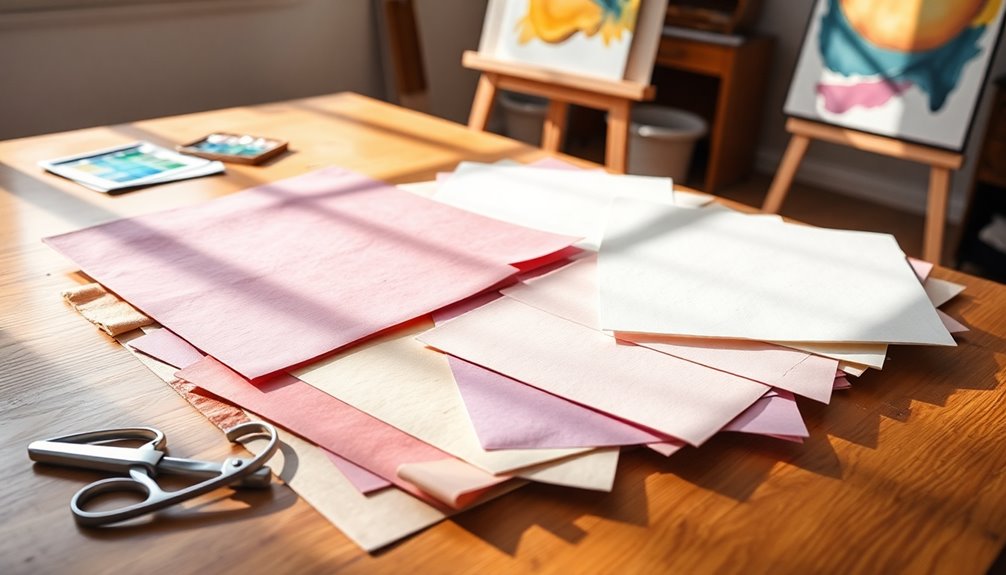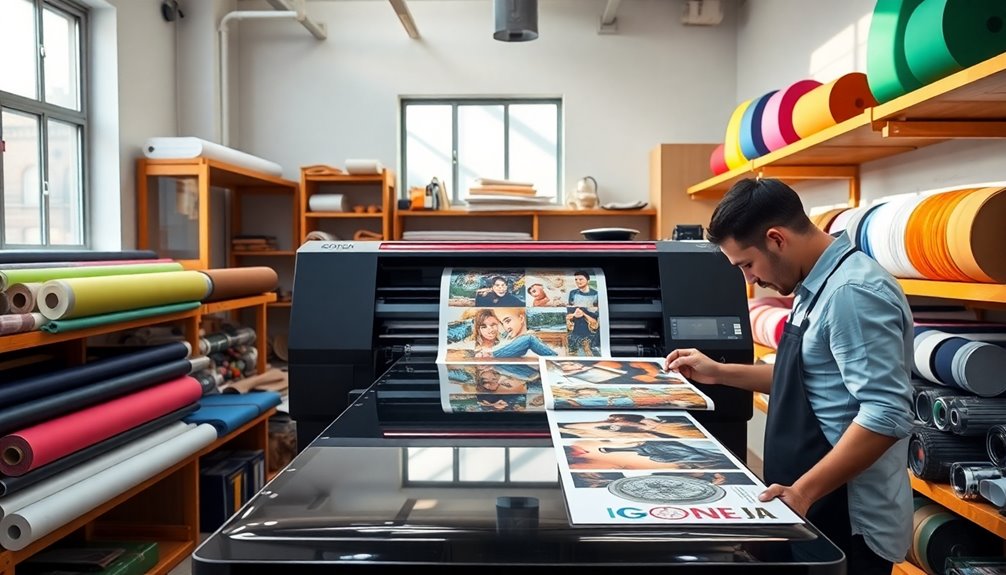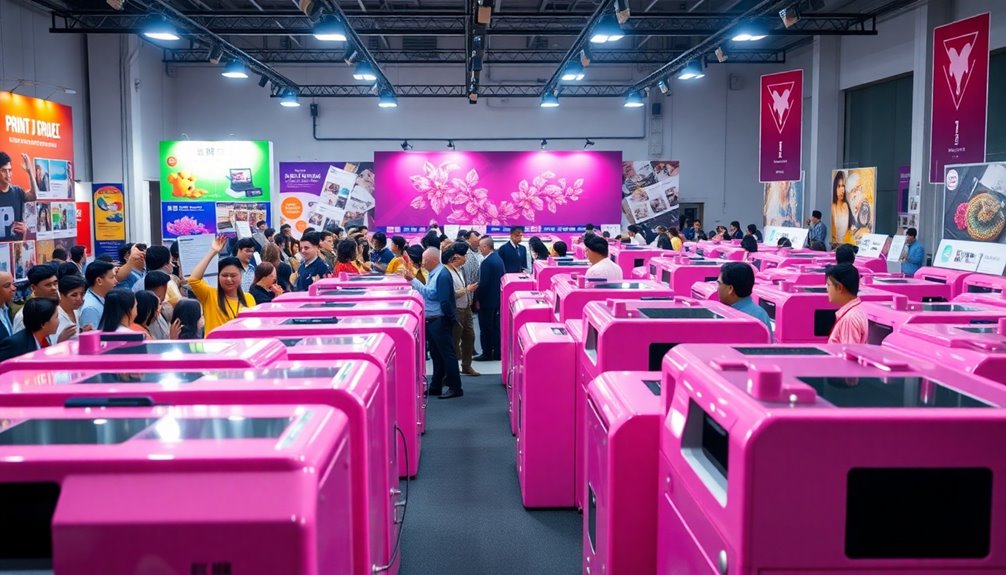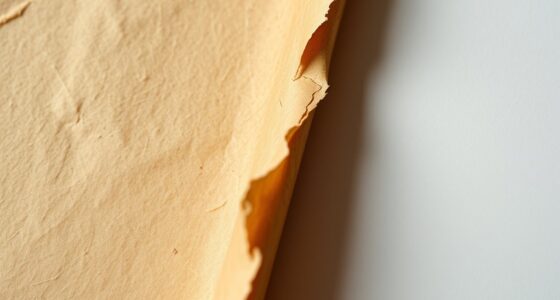Choosing the right paper for your PR materials is essential for standing out and ensuring your message gets across. Start by contemplating the finish; glossy paper makes colors pop, while matte reduces glare and enhances readability. Then, think about weight—heavier stocks feel more premium and improve durability. Don't forget to explore paper grades; text weight is good for high-volume prints but cover weight works better for business cards and brochures. And if sustainability matters to you, look into recycled or eco-friendly options. There's a lot to reflect on, and exploring those factors can really elevate your printed materials.
Key Takeaways
- Determine the purpose of your project to select the appropriate paper type, such as business cards, brochures, or postcards.
- Consider the finish type; gloss enhances color vibrancy, while matte improves readability and professionalism.
- Choose the right weight; heavier paper provides durability and quality for high-impact materials, while lighter weights are suitable for everyday use.
- Opt for suitable paper grades; text grade works for high-volume printing, while cover grade is ideal for sturdier applications like business cards.
- Explore eco-friendly options; recycled paper and sustainably sourced materials reduce environmental impact and align with eco-conscious branding.
Understanding Paper Finish
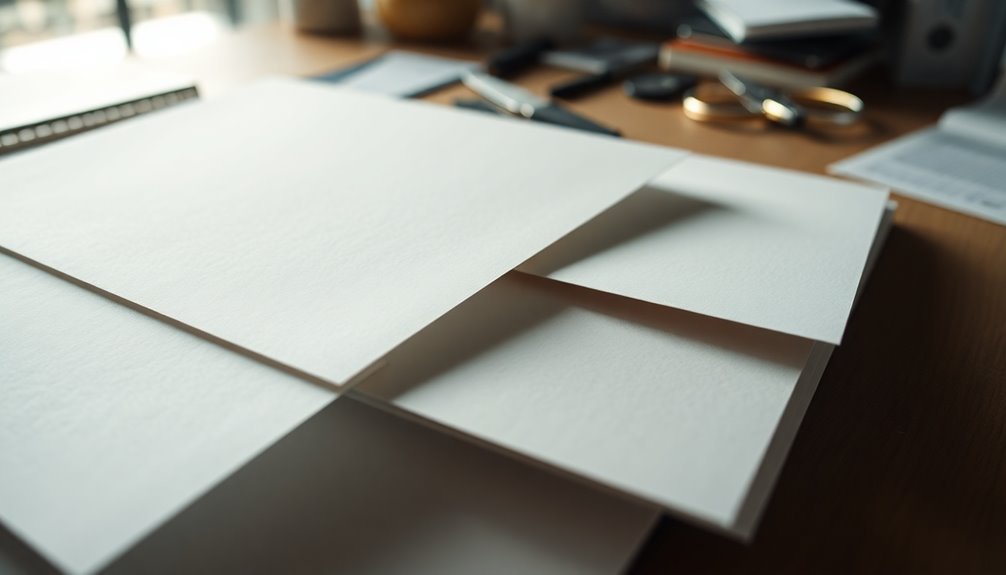
When you're selecting paper for your PR projects, understanding the different finishes is vital. The finish of your paper greatly impacts both the appearance and durability of your print materials.
You've got several options, like gloss, matte, and textured finishes. Gloss-coated paper enhances colors and creates a shiny look, making it perfect for vibrant designs. However, keep in mind that it can produce glare, which might affect readability.
On the other hand, matte finishes reduce glare, leading to improved readability. They're an excellent choice for materials that require easy writing or prolonged viewing, like brochures or reports.
If you're aiming for something unique, consider specialty finishes. Soft touch offers a velvety texture, ideal for premium packaging and promotional materials, while satin finishes provide a subtle sheen that adds versatility to your projects.
Ultimately, understanding these differences in paper finishes helps you choose the right one to meet your specific visual and functional requirements.
Whether you're after high print quality, durability, or a particular aesthetic, the finish you select plays a vital role in achieving your project's goals.
Selecting the Right Weight

Choosing the right paper weight can seem intimidating, but it's significant for guaranteeing your print materials stand out. The weight of the paper, measured in grams per square meter (gsm), greatly influences the overall presentation and effectiveness of your print projects.
Here are three key factors to take into account when selecting the appropriate paper weight:
- Purpose: For business cards and brochures, heavier paper weights (like 80# cover or 100# text) enhance perceived quality and durability. Lighter weights may suffice for everyday office use but can lead to issues like ink bleed-through.
- Printing Performance: Heavier stocks offer greater strength and stability, guaranteeing your printed materials maintain their form. This is essential for professional presentations and marketing collateral.
- Quality and Budget: Keep in mind that while heavier paper may elevate the quality, it also affects your budget. Heavier papers can incur higher printing and shipping costs, so finding a balance is critical.
Understanding these aspects will help you navigate mailing regulations while achieving the desired print quality for your projects.
Make informed choices to guarantee your printed materials leave a lasting impression!
Exploring Paper Grades

Understanding paper grades is essential for selecting the right material for your print projects, as each grade serves a unique purpose.
Paper grades are mainly classified into text grade and cover grade. Text grade paper is thinner and commonly used for items like flyers and letters, while cover grade is thicker and heavier, ideal for business cards and brochures that require sturdiness and a premium feel.
The weight of paper greatly influences its grade, measured in pounds per ream or grams per square meter (gsm). Heavier weights not only enhance the perceived quality but also improve the durability of your final product.
Different papers have specific applications; for instance, text grade is perfect for high-volume printing where cost-effectiveness is key.
When making your paper choice, it's wise to consult with printing experts. They can guide you in selecting the appropriate grade based on your project goals and desired finish.
Understanding these distinctions in paper grades is vital, as the right choice affects the final appearance and functionality of your brochures, catalogs, and other printed materials.
Paper Types and Their Uses
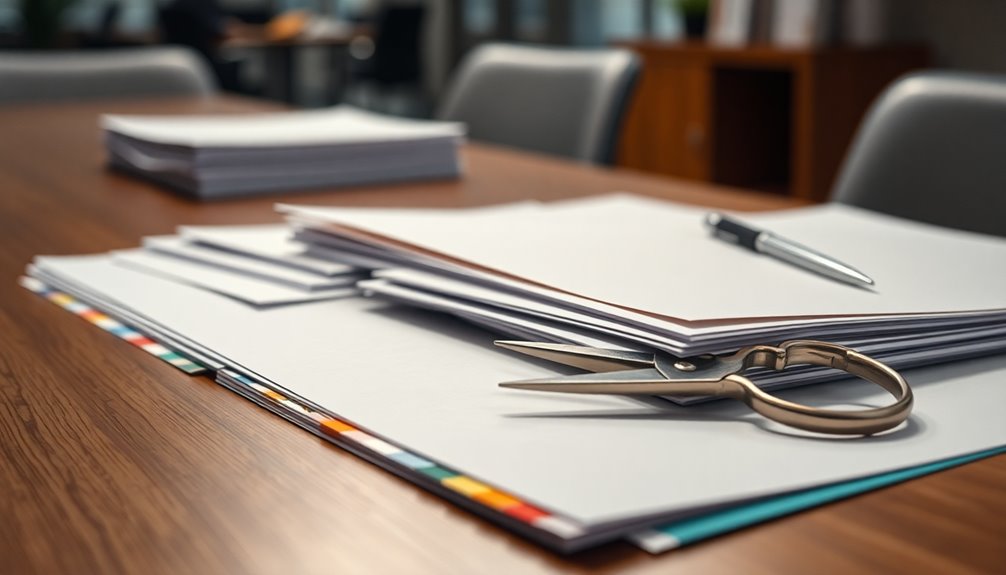
Selecting the right paper type is essential for guaranteeing your printed materials effectively convey your message. Different projects require specific paper types and weights to achieve the desired look and functionality.
Here are three common paper types and their uses:
- Business Card Paper: Choose uncoated stock for a writable surface, or opt for gloss finishes to enhance metallic inks for a vibrant appearance. Soft Touch coatings can provide a luxurious feel.
- Brochure Paper: Go with heavier paper weights, like 100# cover, for durability and a professional look. This guarantees your folded brochures hold up well and comply with mailing requirements.
- Postcard Paper: Typically, use a minimum of 100# cover weight to meet USPS regulations. Consider UV coating for added gloss and protection against outdoor elements.
For catalogs and calendars, use 80# gloss text for the interior and thicker 80# cover stock for the cover, balancing durability and cost.
When designing greeting cards, uncoated stock is great for writing, while textured options like linen add a touch of luxury.
Choose wisely to make your printed materials stand out!
Eco-Friendly Paper Options
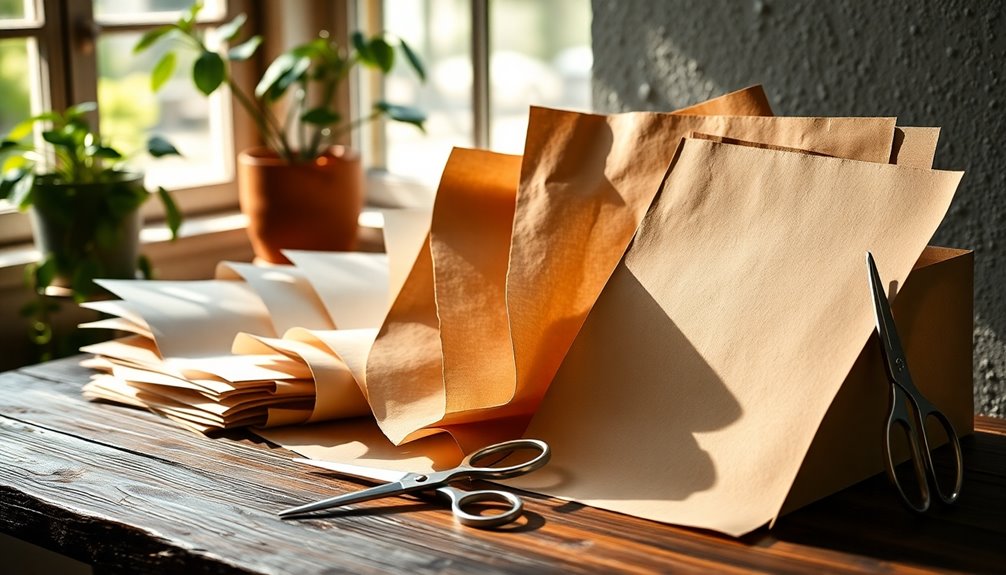
When you're considering eco-friendly paper options, recycled paper is a fantastic choice that helps reduce waste and minimizes deforestation.
Sourcing sustainable paper from responsibly managed forests guarantees that you're contributing to a healthier planet.
Plus, using eco-friendly inks can further amplify the positive impact of your print projects. Additionally, opting for paper products that are high in fiber can enhance sustainability while supporting overall health.
Recycled Paper Benefits
Using recycled paper is a smart choice for anyone looking to make a positive environmental impact. By opting for recycled paper, you not only help reduce the demand for virgin paper but also play a part in conserving our forests.
Here are three key benefits of using recycled paper:
- Lower Carbon Footprint: Recycled paper production requires considerably less energy and water, making it a more sustainable option that helps reduce your overall carbon footprint.
- High-Quality Standards: Many recycled papers maintain comparable brightness and durability to virgin paper, ensuring that you don't have to compromise on quality while supporting eco-friendly practices.
- Enhanced Environmental Reputation: By choosing recycled paper, you align your brand with sustainability. Studies show that 83% of customers prefer brands that demonstrate strong sustainability efforts, boosting your environmental reputation.
Sustainable Sourcing Practices
Beyond the benefits of recycled paper, exploring sustainable sourcing practices opens up a range of eco-friendly paper options that can further enhance your commitment to the environment.
Consider using sustainable papers made from eco-friendly materials, including recycled paper with 60% to 100% post-consumer materials. This choice considerably reduces deforestation and waste.
Look for paper certified by the Forest Stewardship Council (FSC), ensuring it originates from sustainably managed forests that promote responsible forestry practices.
Additionally, biodegradable papers are increasingly available, allowing for easier breakdown in the environment compared to traditional options.
Eco-Friendly Printing Techniques
Eco-friendly printing techniques play an essential role in promoting sustainability in your PR materials. By choosing the right options, you can greatly reduce your environmental impact.
Here are three eco-friendly paper options to take into account:
- Recycled Paper: Made from 60% to 100% recycled paper pulp, this type of paper helps conserve natural resources and reduces waste.
- Sustainable Papers: These are sourced from forests with FSC certification, ensuring responsible management and supporting renewable material cycles, which lowers carbon footprints.
- Biodegradable Papers: Designed to break down naturally, these papers contribute to environmental sustainability by reducing landfill waste.
In addition to selecting the right paper, think about using vegetable-based inks in your printing process. Unlike traditional petroleum-based inks, these sustainable inks enhance the eco-friendliness of your materials.
Key Considerations for Printing
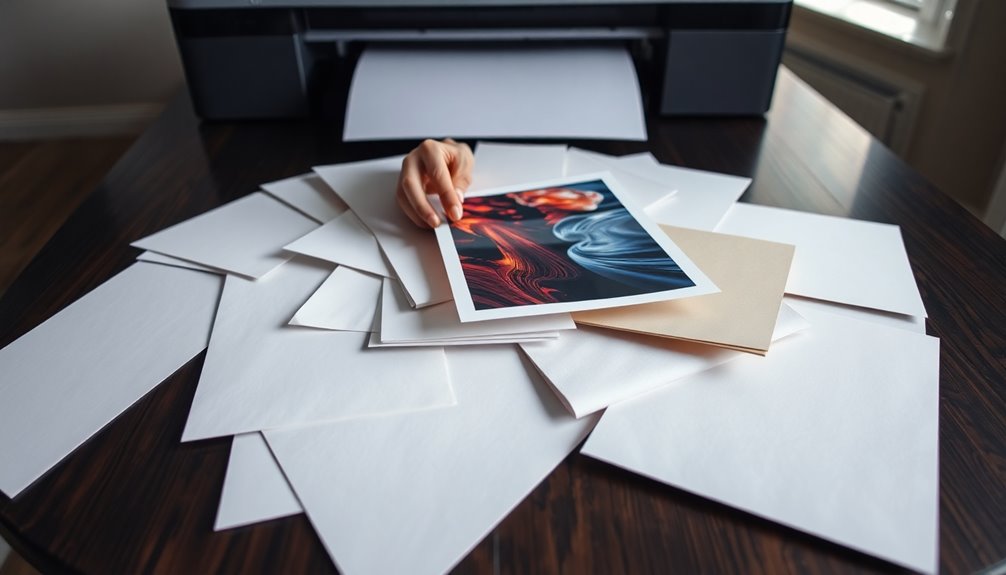
Selecting the right paper for your printing needs can make a significant difference in the final product's quality and impact. Start by considering the weight and thickness of the paper. Heavier weights enhance durability and give your materials a quality feel, with standard copy paper typically ranging from 20 to 24 pounds.
Next, think about the finish. Glossy paper can boost color vibrancy, making it ideal for marketing materials, while matte paper improves readability, which is essential for flyers and brochures.
Don't overlook brightness; it's measured on a scale from 0 to 100 and influences image sharpness and color accuracy. Aim for high-quality papers that score in the 90s for best results.
The intended use of your printed material also matters. Different paper grades, such as text grade for flyers or cover grade for more durable items, impact presentation and longevity.
Finally, consider eco-friendly options like recycled paper. Not only do they support environmental efforts, but they can also enhance your brand's reputation in a market increasingly focused on sustainability.
Choosing the right paper involves balancing these factors to achieve the best outcome for your project.
Frequently Asked Questions
How Do I Choose the Right Paper for Printing?
Choosing the right paper for printing starts with considering your project's purpose.
Think about the type of finish you want—glossy for vibrant colors or matte for better readability.
Check the paper weight, as heavier options offer durability.
Don't forget brightness; a higher level can sharpen images but might wash out softer tones.
Finally, consult with printing professionals to guarantee your paper choice aligns well with your printing method for the best results.
What Paper Is Best for Printing a Birth Certificate?
When printing a birth certificate, you'll want to use a heavier paper weight, like 24 lb or higher, for durability.
Opt for uncoated paper to allow easy writing without smudging. Choose a bright paper with a brightness of 90+ for clarity.
Make sure it's acid-free to prevent yellowing over time. Finally, stick to the standard size of 8.5 x 11 inches, ensuring it fits well in filing systems or frames.
Does It Matter What Paper I Use for My Printer?
Yes, it matters what paper you use for your printer. Each printer works best with specific paper types, like inkjet or laser, and using the wrong one can cause issues like jams or smudging.
You should also consider the paper's weight, brightness, and finish, as these factors affect print quality. If you want vibrant colors and sharp images, choose the right paper that matches your printer's specifications for ideal results.
How Do I Choose a Paper?
To choose paper, start by considering what you need it for. Different projects require different weights and finishes.
For vibrant colors, you might want glossy paper, while matte can enhance readability.
Check the weight, as heavier paper often feels more professional.
Think about brightness and opacity, especially for double-sided printing.
Don't hesitate to ask experts or look up resources to guarantee you pick the right type that fits your project's needs and budget.
Conclusion
Choosing the right paper for your PR materials can make all the difference in how your message is received. By considering factors like finish, weight, and eco-friendly options, you can guarantee your printed pieces reflect your brand's quality and values. Don't forget to think about the specific uses for each paper type, as this will help you craft a powerful impact. With the right choice, your printed materials will stand out and effectively communicate your message.

